MARIANI’S
Virtual
Gourmet
October 16, 2022
NEWSLETTER
Founded in 1996
ARCHIVE
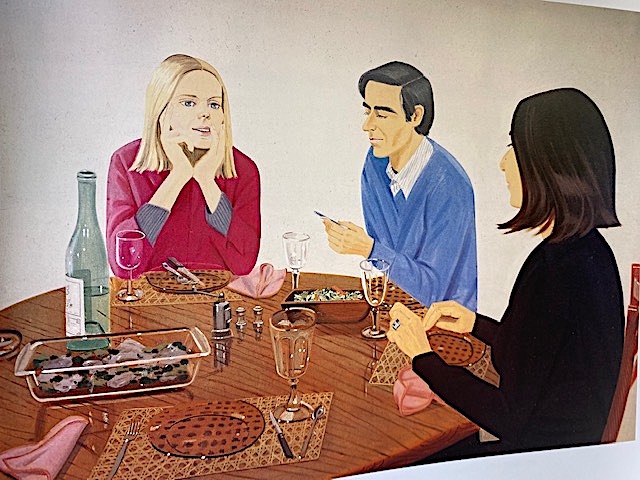
Alex Katz, "Lunch " (1974)
IN THIS ISSUE
HOW MANY RESTAURANTS WILL
MAKE A CELEBRITY CHEF HAPPY?
By John Mariani
NEW YORK CORNER
HOW MANY RESTAURANTS DOES A
CELEBRITY CHEF NEED TO MAKE HIM HAPPY?
By John Mariani
ANOTHER VERMEER
CHAPTER FORTY-ONE
By John Mariani
NOTES FROM THE WINE CELLAR
THE WINES OF THE LANGUEDOC:
AN INTERVIEW WITH MIREN DE LORGERIL
By John Mariani
❖❖❖
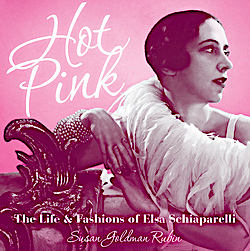 GOLDMAN RUBIN,
biographer and author of HOT PINK: The Life
& Fashions of Elsa Schiaparelli.
Go to: WVOX.com.
The episode will also be archived at: almostgolden.
GOLDMAN RUBIN,
biographer and author of HOT PINK: The Life
& Fashions of Elsa Schiaparelli.
Go to: WVOX.com.
The episode will also be archived at: almostgolden.
❖❖❖
HOW MANY RESTAURANTS DOES IT TAKE TO
MAKE A CELEBRITY CHEF HAPPY?
By John Mariani
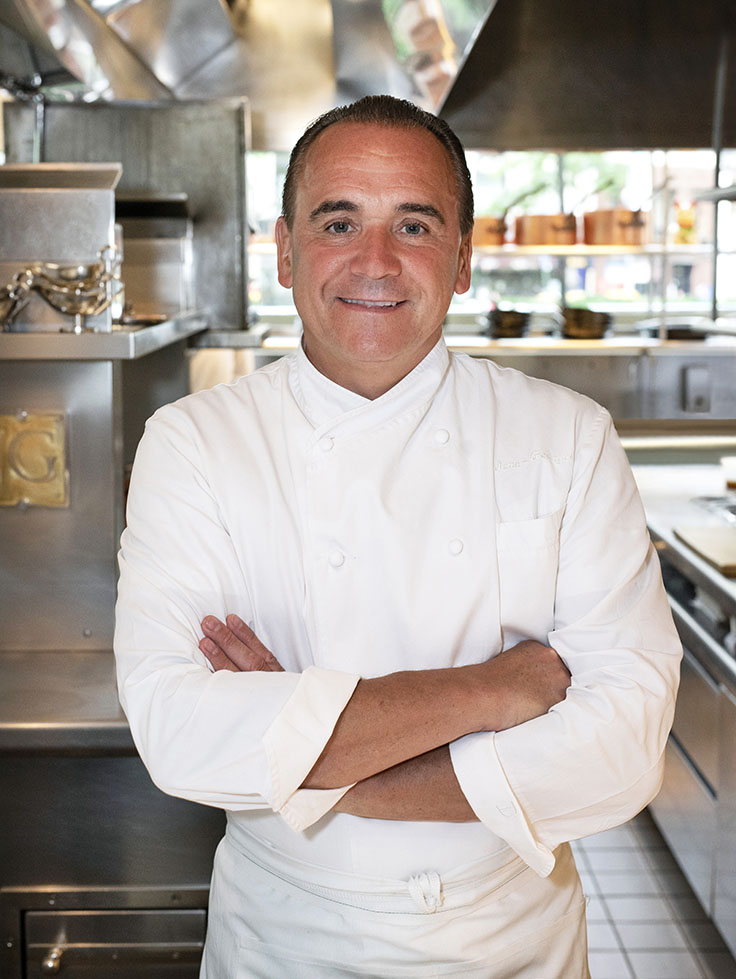 Jean-Georges Vongerichten, the Alsatian
chef who turned 65 this year but still retains a
happy boyish face, is now vying with Alain
Ducasse for the greatest number of restaurants
under his name in the world. He now operates
(though usually does not own) 47 restaurants,
with 13 in New York, three in London and two in
Marrakesh; Ducasse has 31. It goes without
saying that the prospect of JG ever being in
most of his restaurants to oversee what’s going
on means he would barely have time to visit any
of them even once a year.
Jean-Georges Vongerichten, the Alsatian
chef who turned 65 this year but still retains a
happy boyish face, is now vying with Alain
Ducasse for the greatest number of restaurants
under his name in the world. He now operates
(though usually does not own) 47 restaurants,
with 13 in New York, three in London and two in
Marrakesh; Ducasse has 31. It goes without
saying that the prospect of JG ever being in
most of his restaurants to oversee what’s going
on means he would barely have time to visit any
of them even once a year.
Yet, JG’s name is either on the doors or
part of the name, and there seems no signs of his
retirement. Indeed, the investors who buy his name
and expertise are banking on it to attract a very
upscale clientele, who may or may not care if JG
is ever on the premises.
Lest
anyone think I have a low regard for JG, at least
as a hard-working chef, let me say that I was one
of the first to heap praise on him when Louis
Outhier appointed him chef de cuisine at the
Marquis de Lafayette in Boston. The next year,
when he moved to Lafayette in New York, it was my
pick as one of the best new restaurants in America
in Esquire.
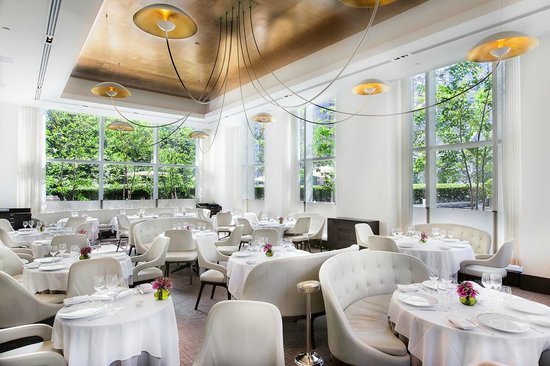 When
he opened his own restaurant, Jean-Georges at
Columbus Circle (right), I declared him
“Chef of the Year,” and when he opened ABC Kitchen
it was my “Restaurant of the Year.” I also really
like his Asian fusion restaurant Vong and his
innovative bistro JoJo. So, I’m
well familiar with just how good he can be when he
has a hands-on approach.
When
he opened his own restaurant, Jean-Georges at
Columbus Circle (right), I declared him
“Chef of the Year,” and when he opened ABC Kitchen
it was my “Restaurant of the Year.” I also really
like his Asian fusion restaurant Vong and his
innovative bistro JoJo. So, I’m
well familiar with just how good he can be when he
has a hands-on approach.
But then things started to slide, and he
and his partners began taking big money from
investors who wanted to grab some of JG’s glow.
Being attracted to Vegas was a no-brainer: All
Steve Wynn wanted at the Bellagio (which he no
longer owns) was a steakhouse. Wynn once told me
he ran into JG there and said, “This is the first
time I’ve seen you here in years,” and JG
answered, “This is the first time I’ve been here
in years.”
 And
to quote the late Paul Bocuse—who, when asked “Who
cooks when you’re not there?” responded, “The same
people who cook when I am
there”—rings a little hollow when ten or twenty or
forty restaurants bear your name. For the record,
there are still celebrated (not celebrity) chefs
like Alain Passard of L’Arpège in Paris, Nadia
Santini of Dal Pescatore near Milan and Masa
Takayama of Masa in New York, who are almost
always in their kitchens cooking.
And
to quote the late Paul Bocuse—who, when asked “Who
cooks when you’re not there?” responded, “The same
people who cook when I am
there”—rings a little hollow when ten or twenty or
forty restaurants bear your name. For the record,
there are still celebrated (not celebrity) chefs
like Alain Passard of L’Arpège in Paris, Nadia
Santini of Dal Pescatore near Milan and Masa
Takayama of Masa in New York, who are almost
always in their kitchens cooking.
I saw what was coming: His place at The
Ocean Club on Paradise Island was terrible, and he
didn’t last long in Dallas. Inevitably, when
contracts ran out, there were closures.
The argument on Jean-Georges Restaurants
company’s part about not needing him to be in his
restaurants is that they hire such top-notch
cooks, often shifted from other JG properties, to
far-flung cities like Hong Kong, Jakarta and São
Paolo. The reality is that in most management
contracts with restaurants a company group
provides, for a training period, someone from the
company to get things going, but the entire staff
is hired 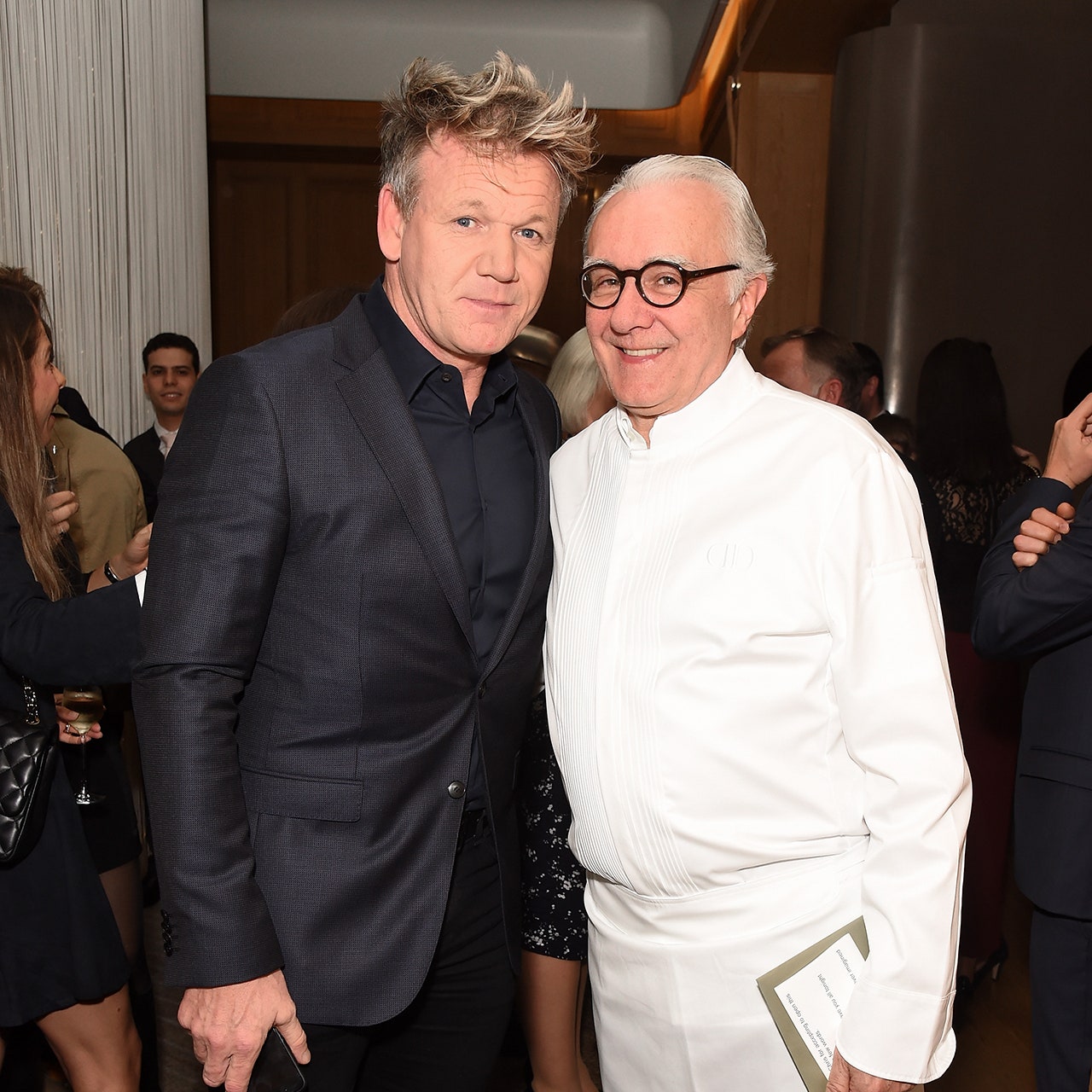 by
the management.
by
the management.
That said, it is remarkable that many
restaurants owned by JG, Ducasse and Gordon Ramsay
(right) turn out a creditable, if diluted,
product. Certain signature items, like JG’s tuna
tartare and chocolate torte, are likely to be
found everywhere. But where you might once might
have sought distinction, the thing that would make
JG’s menu and restaurants stand out from everyone
else’s, you now find the same repetitive clichés
and sure-fire items of shrimp cocktail, grilled
salmon, a flatbread pizza and a cheeseburger.
Little anywhere approaches the exceptional and
innovative food of JG’s New York flagship that
made his reputation.
I recently wrote about a mundane meal at
JG’s outpost in Pound Ridge, NY, which included
the usual hamburger, dry roast chicken and
prosciutto-wrapped pork chop. Last week I ate at
JG’s restaurant called The Mark, at The Mark Hotel
in New York, one of his first contracts after
JoJo.
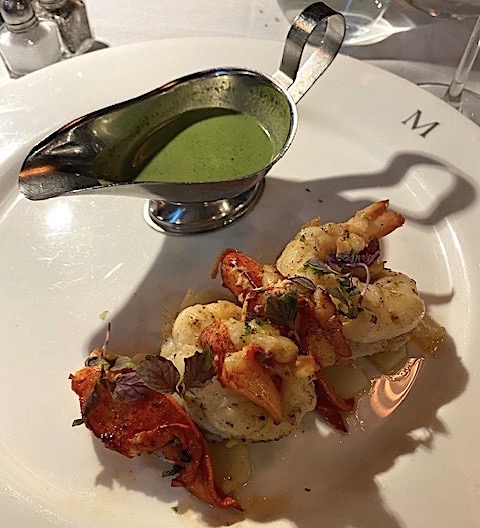 It was more or less the same menu I could
have found in fifty other restaurants around town,
offering caviar ($120 per ounce) and Russ and
Daughters’ smoked salmon ($36). Indian samosas
($28), an odd addition, had
a delicate crust but inside was gray ground beef
with no flavor at all. Neither had the pizza with
black truffles and fontina ($38), whose crust was
a pale shadow of New York’s finest.
It was more or less the same menu I could
have found in fifty other restaurants around town,
offering caviar ($120 per ounce) and Russ and
Daughters’ smoked salmon ($36). Indian samosas
($28), an odd addition, had
a delicate crust but inside was gray ground beef
with no flavor at all. Neither had the pizza with
black truffles and fontina ($38), whose crust was
a pale shadow of New York’s finest.
Lobster came with poached celeriac, green
curry and shiso,
though tame in taste and high in price ($68);
it was a miniature lobster—more like a
Mediterranean crustacean than one from Maine—with
very little meat from the claws or tail, as you
can see from the photo at left. Black sea bass was
very good, very moist, served with braised fennel,
carrots and olives (a whopping $58). A cheese
plate ($30) came cold, but desserts ($19) were all
excellent, from the famous chocolate torte to a
huge portion of profiteroles (right) and a
luscious butterscotch pudding.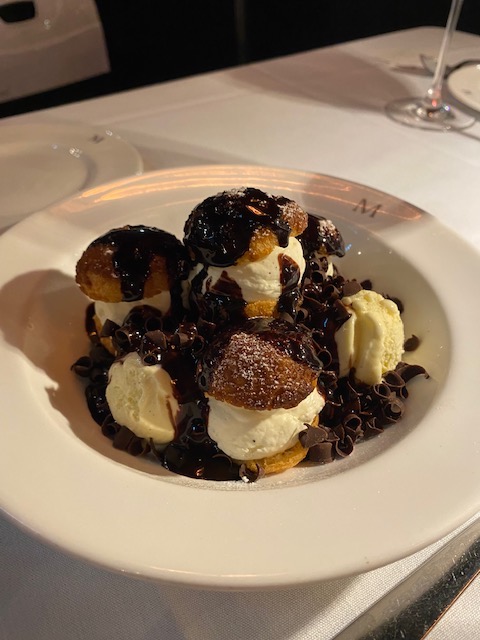
One might come away from such a meal and
say it was pretty good, if predictable, though no
better than one might have had at a hotel dining
room in Phoenix, Atlanta or Pittsburgh. And,
sadly, this is what one now comes to expect from a
restaurant company committed to expansion without
consistent oversight from the principals.
I’m confident that JG is every
bit the great chef he was when he started back in
the 1980s, and, with his partners, has become
admirably rich in the business. God bless
entrepreneurship. Selling out is the usual term
for such a choice, but, when all you’re promoting
is your name, selling the customer short is
perhaps a more realistic description.
❖❖❖
THE STATE OF NEW YORK CITY'S DINING SCENE
By John Mariani
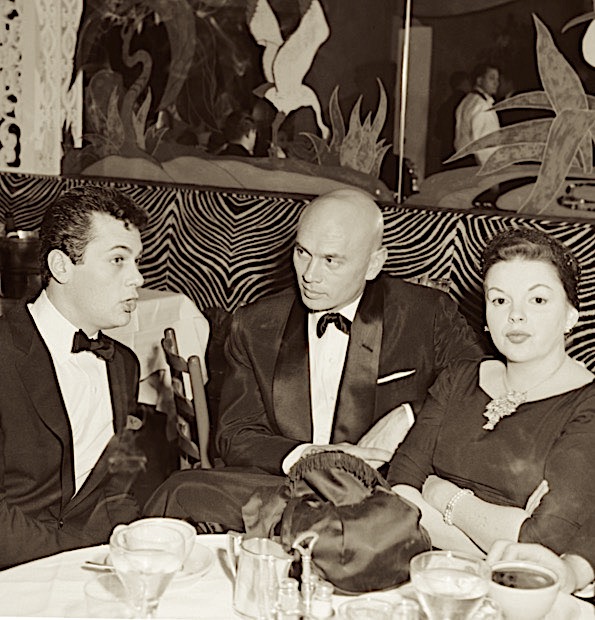
Tony Curtis, Yul Brynner and Judy Garland at El Morocco, 1955
To play on
the question “If a
tree falls in the
forest ...
,” one
might ask “If a
restaurant closes in
New York, how long
before another opens
in the same spot?”
The answer may range
from weeks to
months, but it is
almost guaranteed
that landlords in
the Big Apple rarely
lose rent for long
when it comes to
restaurants. Despite
every newspaper
article and blog
that bemoans the
demise of New York’s
dining scene, the
actual number of
22,000+ eating
establishments in
the city hasn’t
changed since the
1980s.
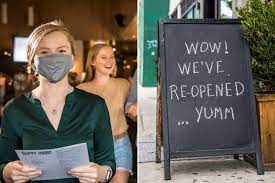 Restaurants
are always opening and
closing in New York,
especially in tough
times like the dot.com
crash, post-911, the
recessions of the late
20th century and, of
course, the Covid
pandemic, which for
long stretches
shuttered every eating
establishment in the
city, as elsewhere.
Restaurants
are always opening and
closing in New York,
especially in tough
times like the dot.com
crash, post-911, the
recessions of the late
20th century and, of
course, the Covid
pandemic, which for
long stretches
shuttered every eating
establishment in the
city, as elsewhere.
And since most
restaurants operate on
a slim net profit,
many upon re-opening
had to attract back
its former clientele
and new people—many of
whom either had Covid
or feared dining out
among those who might.
Even now, people who
learned to work at
home in the suburbs
don’t venture into New
York as much, and
business lunches are
still off.
Covid was a
crushing blow, added
to which, in the
post-pandemic era,
attracting staff, from
cooks to dishwashers,
has been an enormous
problem everywhere.
(Current unemployment
in New York is at 6%,
nationally at 3.5%.)
Then there is
inflation, which has
occurred fast and
furiously in the food
sector, not to mention
energy and
transportation costs.
How can anyone expect
to survive under such
pressures?
Yet,
survive they do,
coping, balancing,
cutting staff and
maybe lunch service,
getting creative with
lesser priced
ingredients, not
re-stocking still-full
wine cellars and
maximizing their
social media. The
result is, if you
merely read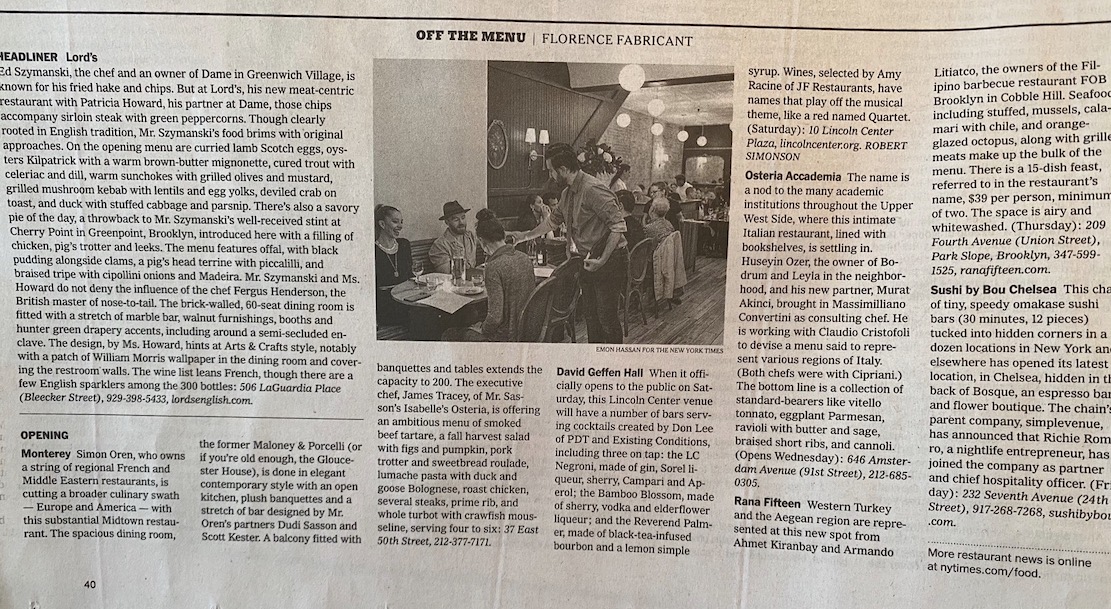 the
Wednesday food section
of The
New York Times,
you’ll find Florence
Fabricant’s weekly
“Off the Menu” column
announcing the opening
of half a dozen
restaurants of every
stripe, with perhaps
notification of one
closing. Also, the
just-published Michelin
Guide to New
York 2022 added six
restaurants with a
one-star ranking, now
totaling 55.
the
Wednesday food section
of The
New York Times,
you’ll find Florence
Fabricant’s weekly
“Off the Menu” column
announcing the opening
of half a dozen
restaurants of every
stripe, with perhaps
notification of one
closing. Also, the
just-published Michelin
Guide to New
York 2022 added six
restaurants with a
one-star ranking, now
totaling 55.
Most of those
food media who cried
wolf at the start of
Covid (when TV
personality Tom
Colicchio insisted 70%
of U.S. restaurants
would close
permanently) would
today have a tough
time getting into
restaurants ranging
from the ultra-fine
dining places like Le
Bernardin to a
steakhouse like Gage
& Tollner in
Brooklyn, and there
are lines out the door
of Mexican,
Argentinian, Thai and
Italian eateries in
SoHo, the Lower East
Side and Dumbo in
Brooklyn. Tasting
dinners at $150 and
more thrive at Eleven
Madison Park,
Serashina Hori, Caviar
Russe, Wicked Jane and
Frevo.
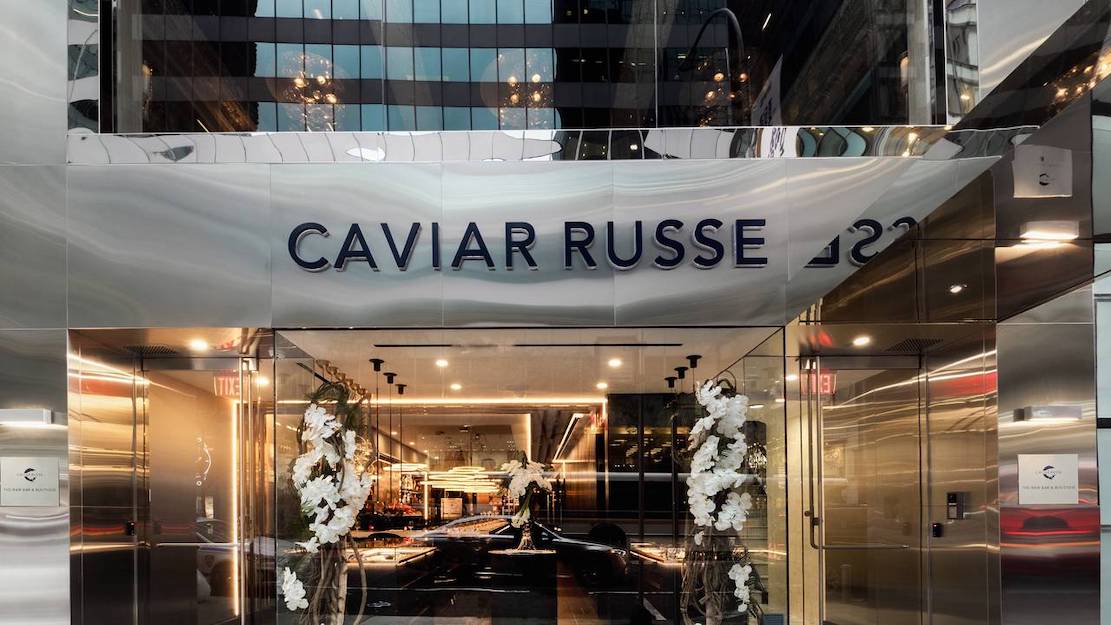 There
were some significant
high-end flops over
the past two years,
including L’Atelier
de Joël Robuchon,
Ichimura at Uchu,
Benno and The Four
Seasons, but all for
different reasons, as
it has ever been. Looking back to a New York
restaurant guide I
co-wrote back in the
1990s, I note that
many of the most
famous and successful
restaurants of those
years were long ago
closed, including big
names like Café
Boulud, Lespinasse,
Picholine, Aureole,
Chanterelle, La
Caravelle, and San
Domenico, all for
various reasons.
There
were some significant
high-end flops over
the past two years,
including L’Atelier
de Joël Robuchon,
Ichimura at Uchu,
Benno and The Four
Seasons, but all for
different reasons, as
it has ever been. Looking back to a New York
restaurant guide I
co-wrote back in the
1990s, I note that
many of the most
famous and successful
restaurants of those
years were long ago
closed, including big
names like Café
Boulud, Lespinasse,
Picholine, Aureole,
Chanterelle, La
Caravelle, and San
Domenico, all for
various reasons.
And as downtown
neighborhoods became
gentrified, many
old-timers like
Canteen, Woo Le Oak,
Da Silvano and Florent
gave way to both
upscale and more
authentic Asian and 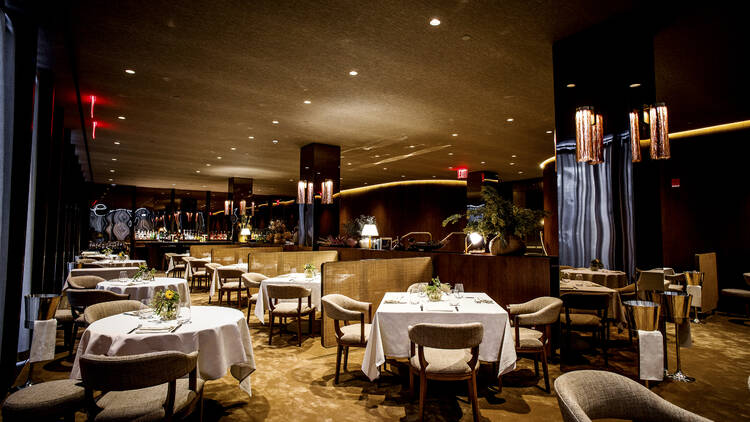 South
American restaurants,
which now proliferate
in those
neighborhoods.
Restaurateurs who
couldn’t absorb a rent
hike were quickly
replaced by those who
believed they could.
South
American restaurants,
which now proliferate
in those
neighborhoods.
Restaurateurs who
couldn’t absorb a rent
hike were quickly
replaced by those who
believed they could.
It seems that
as soon as one
restaurant vacates
premises, a new one
moves right in: The
Four Seasons was
replaced by the
elegant Fasano (right);
Brasserie 8½ became
Cucina 8½; Parma
became Parma Nuova;
Brasserie Ruhlmann is
now Le Rock; A Voce is
Mark’s Off Madison; El
Quijote became a
retro-smash after
re-opening.
Traditional and
new steak and seafood
houses are packed
every night of the
week, including Empire
Steak,  BLT,
Hawksmoor,
Gallaghers and
Ramerino Prime
Italian. Veteran
high-end restaurateurs
like Daniel Boulud
opened two new
restaurants, Le
Pavilllon and Le
Gratin; Danny Meyer
opened Ci Siamo and
re-opened Manahatta
and Maialino.
BLT,
Hawksmoor,
Gallaghers and
Ramerino Prime
Italian. Veteran
high-end restaurateurs
like Daniel Boulud
opened two new
restaurants, Le
Pavilllon and Le
Gratin; Danny Meyer
opened Ci Siamo and
re-opened Manahatta
and Maialino.
The remarkable
thing is that these
closings
and openings
might have happened at
any time in the past
two decades, and, if
Covid, inflation and
staff shortages make
running a restaurant
all the tougher, it
says a great deal
about those men and
women willing to buck
odds that even in good
times dictate that
four out of five new
restaurants go out of
business within two
years.
But
that’s the thing about
New York: One door
closes and another one
opens, and those chefs
and restaurateurs, who
agree they might be
crazy, are undaunted
because, like all
small business men and
women, they just have
to try. And it’s still
true that New York is
still the big prize.
ANOTHER VERMEER

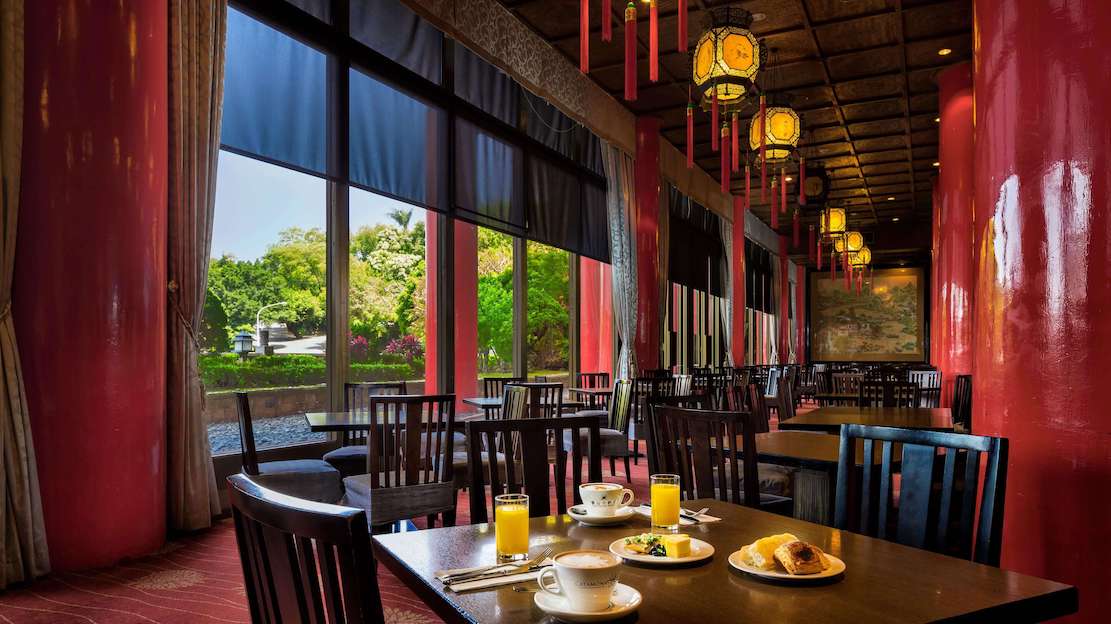 A
little after eight o’clock Katie and
David were in the hotel’s Garden Café, having tea
and coffee, with no appetite to eat after what
already had occurred that morning. David filled
her in on his conversation with Kiley, which had
Katie shaking her head, at first in disbelief,
then trying to connect all the dots in what had
now become a murder case.
A
little after eight o’clock Katie and
David were in the hotel’s Garden Café, having tea
and coffee, with no appetite to eat after what
already had occurred that morning. David filled
her in on his conversation with Kiley, which had
Katie shaking her head, at first in disbelief,
then trying to connect all the dots in what had
now become a murder case.
“Y’know, Katie,” said David, “You really
don’t have to do this interview. Shui’s a murderer
on a global level, and since it’s all going to
come out tomorrow in the papers—here, too, I’m
sure—you can write this part of the story without
interviewing the bastard. There’ll be lots more to
the story you can report on, both before and after
the auction.”
“David,” said Katie, “If you were in my
shoes, you’re saying you wouldn’t go ahead with
the interview? I’ll have the first utterances of
this guy, before he even knows about Chin spilling
the beans. No other reporter is even in the same
ballpark—that would be Taipe. Aren’t you the
slightest bit interested what our would-be
murderer has to say to you, an old cop?”
David hated that she said “old” but let it
go.
“You’re right. I do want to see the little
shit and grill him. But there’s a wrinkle here,
Katie. When we show up for our appointment less
than two hours
from now, Shui’s going to be pretty surprised to
see us. He thinks we’re dead.”
“What if Chou told him it wasn’t us who got
killed?”
“He might, but all this just happened an
hour ago. Chou’s been up to his ears dealing with
this crisis; he has no reason to call Shui.
Neither do the police at this point, though
they’ll be very interested to follow up on the
room switch. Even if Shui’s people called the
hotel, say, to ask about us—the two Americans he
arranged to stay in the grand suite—unless he
spoke directly with Chou, the management would
probably just say two American were found dead
after a gas leak.
“Remember
yesterday, when we checked in and you refused to
accept Shui’s hospitality, Chou said he’d have to
smooth that over with Shui. Probably worrying he’d
lose face as a general manager. So maybe he hadn’t
got around to telling Shui anything since
yesterday. At this moment Shui probably hasn’t
heard anything at all, or, if he did, he probably
hasn’t spoken to Chou yet. Hell, it’s only
eight-fifteen in the morning.”
“You may be right,” said Katie, “though I
suspect Shui has one of his people in the hotel
with his ear to the wall.”
“If he does, the guy who committed the
murder would have contacted Shui’s man and said it
all went off without a hitch.”
“That makes sense. Wonder how he did it.”
“The murderer probably paid someone off,
got hold of a master key, got inside the suite and
either punctured the gas line or loosened a valve
or a connection. Our friends never knew they were
dying a slow, peaceful death.”
“It’s so absolutely horrible,” said Katie,
placing her cup of cold tea on the saucer. “And to
think it was supposed to be us. Why the hell would
he want us
dead?”
“I don’t know, unless somehow he thought
you were going to get too much awkward information
out of him, after what Coleman had already
published about him.”
“Yeah, but Coleman said Shui was only too
glad to meet with us. That was just last week.”
“Well, let’s see Shui’s reaction when we
show up,” said David. “Hey, we better get moving.
I hope our new rooms are ready.”
They were, and Katie
and David changed into something more suitable for
an interview. Katie checked her pocket tape
recorder. David went downstairs to get a taxi.
© John Mariani, 2016
❖❖❖
THE WINES OF THE LANGUEDOC:
AN INTERVIEW WITH MIREN DE LORGERIL
BY JOHN MARIANI
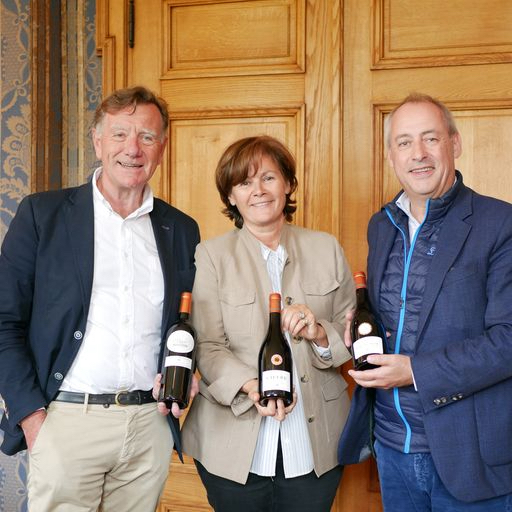
Nicolas and Miren de Lorgeril with Albéric Bichot, CEO of Bichot wines
The wines of the
Languedoc, or Languedoc-Roussillon, in the south
of French have long been known more for their bulk
than their quality, with much of the oversupply
made into neutral alcohol. Thousands of
cooperatives owned by tradition-bound farmers
maintained the old ways. But in
the 1990s the more individualized, more
forward-thinking vintners, saw that with
improvement in vineyard management, technology and
focus on terroir the Languedoc’s wines could
compete readily with better-known regions’, not
least the Rhône valley to the northeast where
Syrah and Grenache are dominant and increasingly
of high quality in the Languedoc. To get an update
on the state of the region’s viticulture, I
interviewed Miren de Lorgeril of Maison Lorgeril,
with links back to 1620 and whose consultant until
2018 was Patrick Léon, formerly technical director
of Domaine Baron Philippe Rothschild.
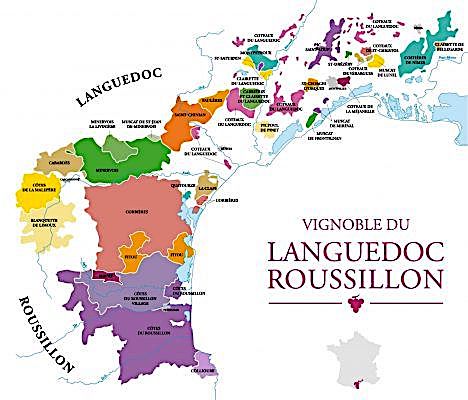
Your
family in the region goes back more than 400
years. Were they known for making good Languedoc
wines in the 18th and 19th centuries?
We have
very few references about the history. I do know
that the wines of Pennautier were served to the
royal officers in 1701.
The
Languedoc has hundreds of cooperatives making
enormous amounts of wine, some of which was turned
into Europe's alcohol lake. Are those cooperatives
still very conservative in the way they make their
wines?
Due to
huge efforts in the last 20 years, at least 70% of
theses cooperatives have changed their options and
are now producing vin de cépages
at the standard level, at least, and 20% to 30% have
become HVE or organic. Their technical obligations
for the wine growers have considerably been
increased, so their difficulties are not linked to
the quality of wine but to the concurrency of other
countries wines that
don’t have the same costs as, say, Spain.
That is why some millésime have not been completely
sold and turned into alcohol.
Do you
think that the best wines of the Languedoc compare
with the fine wines of both Bordeaux and Burgundy?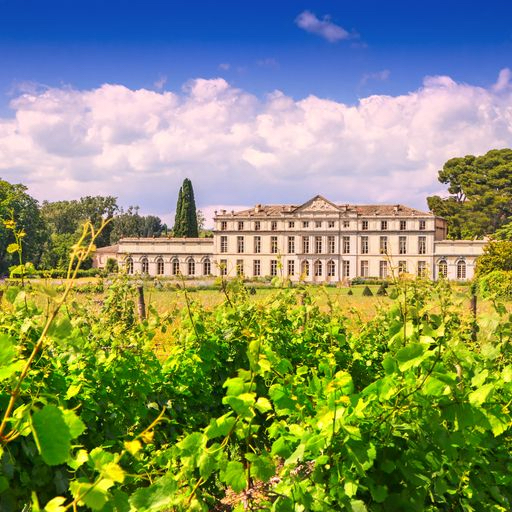
Each
region is different. Burgundy
is a tiny region with an exceptional level of
knowledge by parcel, which is the fruit of history.
Bordeaux is a region with a huge difference between
some top wines and a large production at middle
level. Languedoc AOP has the size of Burgundy and
has an ambition of excellence, so that some of
the greatest wines of Languedoc have that same
ambition and are now reaching the top levels. We are
working with the same technics and equipment as
Burgundy and Bordeaux, so we might reach these levels. Some of
the AOP combination of soils and micro-climates are
at the same level, and we are sure that these levels
of quality are reached for some and reachable for
many.
Your
Chardonnay is a very fine example of the French
style for that varietal. How is your Chardonnay
made?
Our
chardonnay Marquis de Pennautier, Pays d’Oc is
produced on limestone/clay soils. The grapes are
hand-picked at a fresh hour, between
six to ten in the morning, to have natural
freshness. 50% is vinified in oak and the rest
vinified in tanks.
How
important are the sea winds to the terroir of your
vineyards?
Our
terroir of Château de Pennautier is settled in a
place where Pyrénées and Massif Central are nearly
joining, close to Carcassonne. It is a naturel place
for air flow, so the winds are accelerated and more
powerful. The wind coming from the Mediterranean
(southeast) is rather powerful, since the sea is
close by, at 70 km, while the winds from the
Atlantic (300 km) are reaching the region after
crossing the southwest of France, where there is no
natural obstacle to stop them, and they arrive in
this narrow region and face the Mediterranean wind.
This gives many occasions for rain and fresh air,
which is excellent for the balance of the wine.
Has
Agro-tourism been important in the Languedoc? Can
people visit your estate?
Agro-tourism
is important in Languedoc and increasing: 30% of the
famous estates are open to the public for wine
tasting; 10% for larger visits. We have been
pioneers in that matter, opening to the public in
2002, with a tasting, cellar, restaurant and rental
houses in the vineyard. The castle itself is an
historical monument, and the garden is classified as
Jardin
remarquable. The tour in the garden is open every day,
and the castle
is open for rental for seminars and events,
including 24 bedrooms for groups.
How do
you think you can defend against the worst aspects
of climate change?
We are
adapting strongly to the climate change in many
ways. Plantings are
higher and higher in altitude. Greens cover
is used in the vineyard during winter to
dynamize natural fertilization and help the roots of
the vineyard to go down deep. It also increases the
organic life in the soil. We also pay attention to
the quality of global vineyard environment in the
trees, bees and all natural life around the
vineyards. We use irrigation in some parcels where
it is possible.
What
makes your wines organic and why is it so much
more expensive to produce?
The
organic charter is granting us the label Bio, which
means no chemicals use in the vineyard. In
consequence, many of the actions have to been
managed by hand, so we have to come more often in
the vineyard for different actions, which
costs at
least 50% more in workforce.
What are
your largest export markets?
Canada is
the first, then UK, Japan, and USA is becoming
quickly an important market that should be the 4th
in 2023.
How have
you managed to keep prices moderate by comparison
with other French regional wines?
The key
point is the land price. As the region has been less
known in the last 40 years, the increase of the
price is not important, compared to other famous
regions.
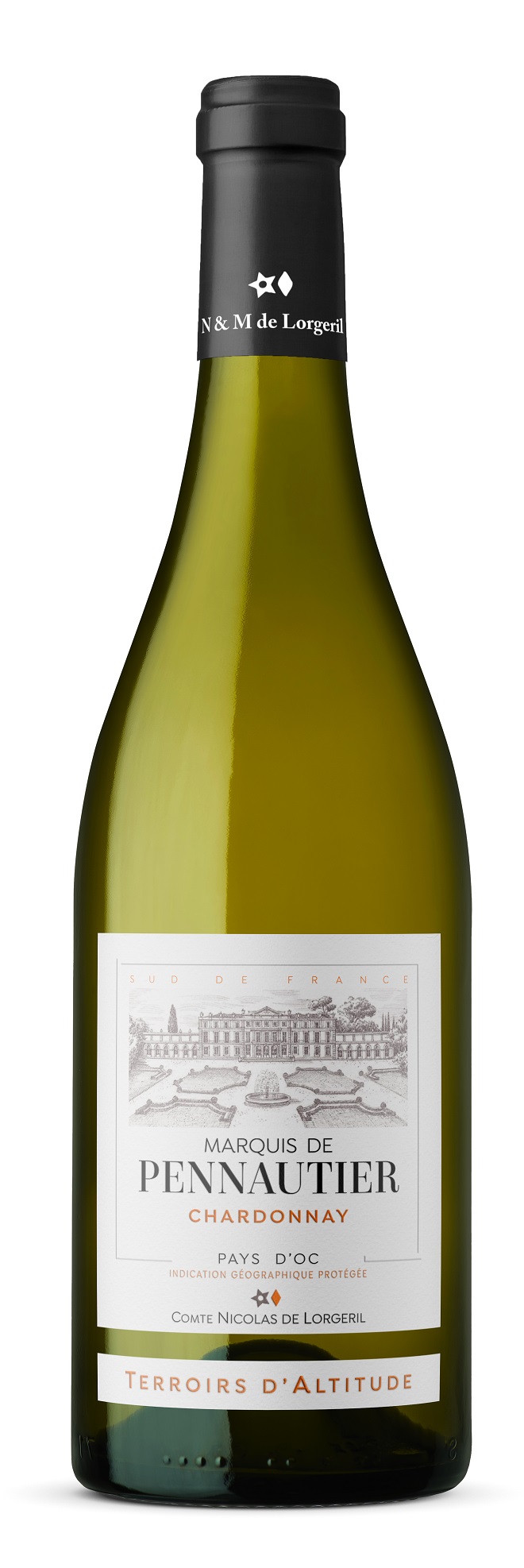
You have
four children but none of them yet show an
interest in the winemaking at your estate. Do you
think this will change, and why?
Our
children are still young and we have asked them to
reach the top of their ambition and then to add a
personal experience in other businesses and regions
in order to come back with knowledge and open minds.
They have graduated in the very best universities,
and they are working now in very top companies. They
are already involved in many occasions as tastings,
harvests, board, and we have asked them to come back
in the next 5 years.
The war
in the Ukraine has prevented you from exporting to
Russia. Has that been a problem financially?
Russia was
for us a small market, so it is not a big financial
loss. We are very sorry for our partners who are
suffering a lot.
Is the
Languedoc ready to start making Pinot Noir and
Cabernet Sauvignon, and, if so, why bother, rather
than stay with the traditional varieties of the
region?
These two
varietals are already developed in the west part of
Languedoc, where the climate is adapted. Limoux and
Cabardès have been planted with such varietals
because they match very well with the climate and
with high-altitude parcels. In these parts, the
local varieties, such as Syrah and Grenache, are
less adapted.
How would you say your wines made with varietals
predominant in the Rhône valley different from
those made there?
It is
always difficult to compare such a large region as
Rhone with a lot of differences. Grenache and Syrah
are settled in AOP Languedoc on high terroirs, on
great varieties of soils but well balanced between
altitude, clay and stones as
schistes/limestone/sandstone. The Rhône is probably
a little warmer, less impacted by winds and more
stony (less clay to balance) and warmer nights.
❖❖❖

YOU GO, GIRL!
"I’m Finally Getting Rid of my Instant Pot, and I’m Not the Only One," Bettina Makalintal, Eater.com (9/13/22)
❖❖❖
Any of John Mariani's books below may be ordered from amazon.com.
 The Hound in Heaven
(21st Century Lion Books) is a novella, and
for anyone who loves dogs, Christmas, romance,
inspiration, even the supernatural, I hope you'll find
this to be a treasured favorite. The story
concerns how, after a New England teacher, his wife and
their two daughters adopt a stray puppy found in their
barn in northern Maine, their lives seem full of promise.
But when tragedy strikes, their wonderful dog Lazarus and
the spirit of Christmas are the only things that may bring
his master back from the edge of despair.
The Hound in Heaven
(21st Century Lion Books) is a novella, and
for anyone who loves dogs, Christmas, romance,
inspiration, even the supernatural, I hope you'll find
this to be a treasured favorite. The story
concerns how, after a New England teacher, his wife and
their two daughters adopt a stray puppy found in their
barn in northern Maine, their lives seem full of promise.
But when tragedy strikes, their wonderful dog Lazarus and
the spirit of Christmas are the only things that may bring
his master back from the edge of despair. WATCH THE VIDEO!
“What a huge surprise turn this story took! I was completely stunned! I truly enjoyed this book and its message.” – Actress Ali MacGraw
“He had me at Page One. The amount of heart, human insight, soul searching, and deft literary strength that John Mariani pours into this airtight novella is vertigo-inducing. Perhaps ‘wow’ would be the best comment.” – James Dalessandro, author of Bohemian Heart and 1906.
“John Mariani’s Hound in Heaven starts with a well-painted portrayal of an American family, along with the requisite dog. A surprise event flips the action of the novel and captures us for a voyage leading to a hopeful and heart-warming message. A page turning, one sitting read, it’s the perfect antidote for the winter and promotion of holiday celebration.” – Ann Pearlman, author of The Christmas Cookie Club and A Gift for my Sister.
“John Mariani’s concise, achingly beautiful novella pulls a literary rabbit out of a hat – a mash-up of the cosmic and the intimate, the tragic and the heart-warming – a Christmas tale for all ages, and all faiths. Read it to your children, read it to yourself… but read it. Early and often. Highly recommended.” – Jay Bonansinga, New York Times bestselling author of Pinkerton’s War, The Sinking of The Eastland, and The Walking Dead: The Road To Woodbury.
“Amazing things happen when you open your heart to an animal. The Hound in Heaven delivers a powerful story of healing that is forged in the spiritual relationship between a man and his best friend. The book brings a message of hope that can enrich our images of family, love, and loss.” – Dr. Barbara Royal, author of The Royal Treatment.
 |
The Encyclopedia of American Food and Drink by John F. Mariani (Bloomsbury USA, $35) Modesty forbids me to praise my own new book, but let me proudly say that it is an extensive revision of the 4th edition that appeared more than a decade ago, before locavores, molecular cuisine, modernist cuisine, the Food Network and so much more, now included. Word origins have been completely updated, as have per capita consumption and production stats. Most important, for the first time since publication in the 1980s, the book includes more than 100 biographies of Americans who have changed the way we cook, eat and drink -- from Fannie Farmer and Julia Child to Robert Mondavi and Thomas Keller. "This book is amazing! It has entries for everything from `abalone' to `zwieback,' plus more than 500 recipes for classic American dishes and drinks."--Devra First, The Boston Globe. "Much needed in any kitchen library."--Bon Appetit. |
"Eating Italian will never be the same after reading John Mariani's entertaining and savory gastronomical history of the cuisine of Italy and how it won over appetites worldwide. . . . This book is such a tasteful narrative that it will literally make you hungry for Italian food and arouse your appetite for gastronomical history."--Don Oldenburg, USA Today. "Italian
restaurants--some good, some glitzy--far
outnumber their French rivals. Many of
these establishments are zestfully described
in How Italian Food Conquered the World, an
entertaining and fact-filled chronicle by
food-and-wine correspondent John F.
Mariani."--Aram Bakshian Jr., Wall Street
Journal.
"Equal parts
history, sociology, gastronomy, and just
plain fun, How Italian Food Conquered the
World tells the captivating and delicious
story of the (let's face it) everybody's
favorite cuisine with clarity, verve and
more than one surprise."--Colman Andrews,
editorial director of The Daily
Meal.com. "A fantastic and fascinating
read, covering everything from the influence
of Venice's spice trade to the impact of
Italian immigrants in America and the
evolution of alta cucina. This book will
serve as a terrific resource to anyone
interested in the real story of Italian
food."--Mary Ann Esposito, host of PBS-TV's
Ciao
Italia. "John Mariani has written the
definitive history of how Italians won their
way into our hearts, minds, and
stomachs. It's a story of pleasure over
pomp and taste over technique."--Danny Meyer,
owner of NYC restaurants Union Square
Cafe, The Modern, and Maialino.
|
 |
 |
 |
 |
 |
 |
 Everett Potter's Travel Report:
Everett Potter's Travel Report: 
 Eating Las
Vegas
Eating Las
Vegas
MARIANI'S VIRTUAL GOURMET
NEWSLETTER is published weekly. Publisher: John Mariani. Editor: Walter Bagley. Contributing Writers: Christopher
Mariani, Misha Mariani, John A. Curtas, Gerry Dawes, Geoff Kalish.
Contributing
Photographer: Galina Dargery. Technical
Advisor: Gerry
McLoughlin.
If you wish to subscribe to this
newsletter, please click here: http://www.johnmariani.com/subscribe/index.html
© copyright John Mariani 2022
